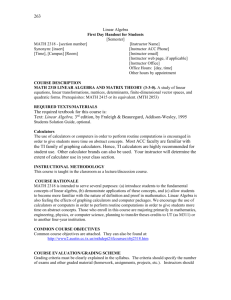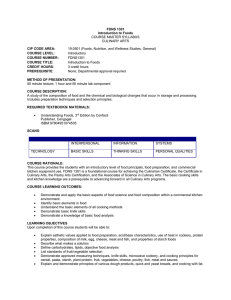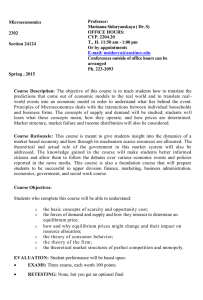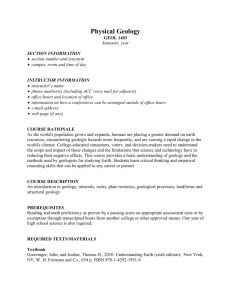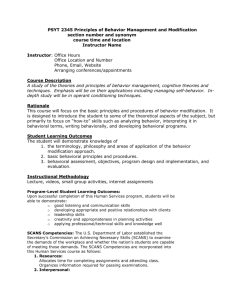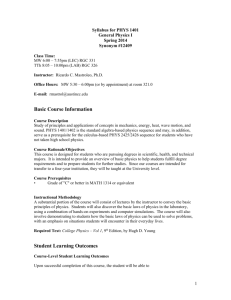Master Syllabus - Austin Community College
advertisement
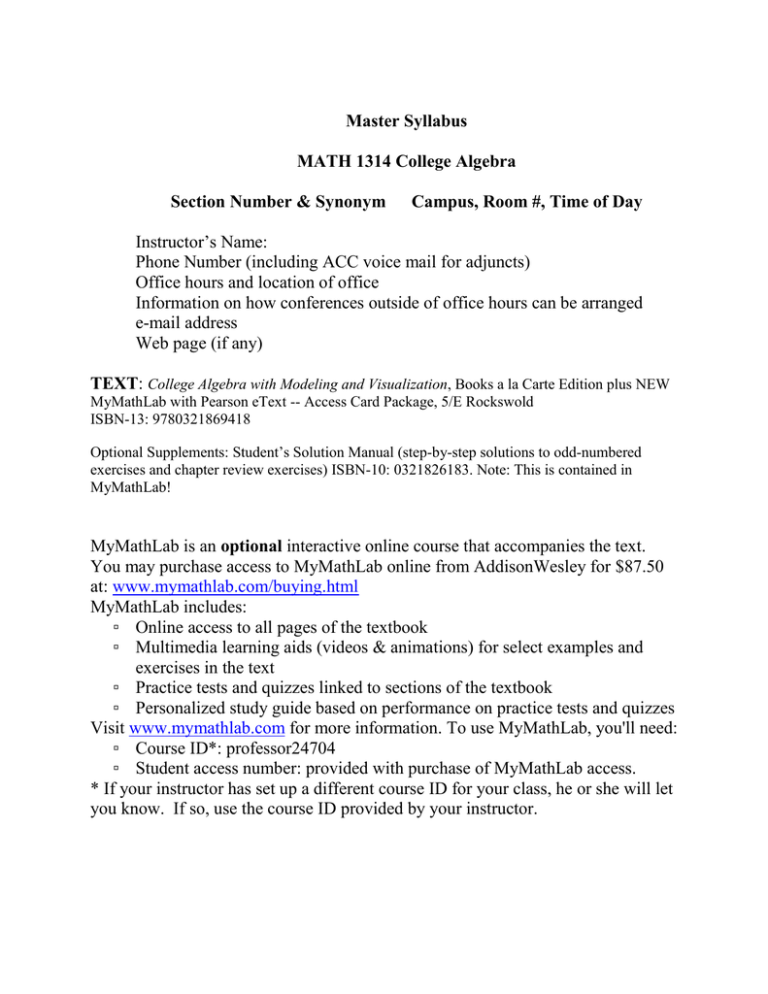
Master Syllabus MATH 1314 College Algebra Section Number & Synonym Campus, Room #, Time of Day Instructor’s Name: Phone Number (including ACC voice mail for adjuncts) Office hours and location of office Information on how conferences outside of office hours can be arranged e-mail address Web page (if any) TEXT: College Algebra with Modeling and Visualization, Books a la Carte Edition plus NEW MyMathLab with Pearson eText -- Access Card Package, 5/E Rockswold ISBN-13: 9780321869418 Optional Supplements: Student’s Solution Manual (step-by-step solutions to odd-numbered exercises and chapter review exercises) ISBN-10: 0321826183. Note: This is contained in MyMathLab! MyMathLab is an optional interactive online course that accompanies the text. You may purchase access to MyMathLab online from AddisonWesley for $87.50 at: www.mymathlab.com/buying.html MyMathLab includes: ▫ Online access to all pages of the textbook ▫ Multimedia learning aids (videos & animations) for select examples and exercises in the text ▫ Practice tests and quizzes linked to sections of the textbook ▫ Personalized study guide based on performance on practice tests and quizzes Visit www.mymathlab.com for more information. To use MyMathLab, you'll need: ▫ Course ID*: professor24704 ▫ Student access number: provided with purchase of MyMathLab access. * If your instructor has set up a different course ID for your class, he or she will let you know. If so, use the course ID provided by your instructor. COURSE DESCRIPTION MATH 1314 COLLEGE ALGEBRA (3-3-0). A course designed for students majoring in business, mathematics, science, engineering, or certain engineeringrelated technical fields. Content includes the rational, real, and complex number systems; the study of functions including polynomial, rational, exponential, and logarithmic functions and related equations; inequalities; and systems of linear equations and determinants. Prerequisites: MATD 0390 or satisfactory score on the ACC Assessment Test. (MTH 1743) Course Prerequisite: Intermediate Algebra (MATD 0390) or current knowledge of high school algebra as measured by the Assessment Test. Students who have a great deal of difficulty with the Pretest and/or review and have not had Intermediate Algebra or its equivalent recently should consider withdrawing and taking Intermediate Algebra. Calculator: Students need either a scientific or business calculator. (Has log or ln key.) If a student cannot purchase one, calculators are available from the LRS. Graphing calculators are not required, but you will use graphing technology in most sections of the book. Graphing calculators are also available in the LRS. Most ACC faculty are familiar with the TI family of graphing calculators. Hence, TI calculators are highly recommended for student use. Other calculator brands can also be used. Your instructor will determine the extent of calculator use in your class section. INSTRUCTIONAL METHODOLOGY This course is taught in the classroom primarily as a lecture/discussion course. COURSE RATIONALE This course is designed to teach students the functional approach to mathematical relationships that they will need for a business calculus sequence. Other courses, such as MATH 1332, or MATH 1342 are more appropriate to meet a general mathematics requirement. Check with your degree plan as to what math course your college requires. COMMON COURSE OBJECTIVES Common course objectives are attached. They can also be found at: https://sites.google.com/a/austincc.edu/math-students/documents/objectives Note: include these in your syllabus. MATH 1314 College Algebra -- Objectives Functions: Use and interpret functional notation. Find the domain of polynomial, rational, radical, exponential, and logarithmic functions. Find a symbolic representation of the sum, difference, product, quotient, and composition of two functions. Evaluate the sum, difference, product, quotient, and composition of two functions at a given value of the respective domain for functions represented symbolically, graphically, and numerically. Find the inverse of a function represented symbolically, graphically, or numerically. Interpret the graphs of functions. Graphing functions: Sketch the graphs of the following functions: Lines, x2, x3, x1/2, 1/x, 1/x2, |x|, factored polynomials of degree 3 or more, ax, logax, and rigid transformations of these functions. Describe the end behavior of polynomial functions. Approximate the zeros of a function from its graph. Solve an inequality involving a function from its graph. Graph a piece-wise defined function. Symbolic Adeptness: Solve polynomial, rational, exponential, and logarithmic equations symbolically. Solve equations involving radicals symbolically. Solve equations with rational exponents symbolically. Solve equations with negative exponents symbolically. Solve polynomial and rational inequalities symbolically. Use the Fundamental Theorem of Algebra and the Conjugate Zeros Theorem to find zeros of polynomials of degree three or greater. Find the vertex of a parabola and the center and radius of a circle by completing the square. Find the vertex of a parabola written in standard form by using the formula h = -b/2a. Convert an exponential equation to logarithmic form, and a logarithmic equation to exponential form. Evaluate exponential and logarithmic functions using the change of base formula and a calculator. Use the properties of logarithms to expand a logarithmic expression, and to write an expanded logarithmic expression as a single logarithm. Solve a system of linear equations using Gaussian elimination. Solve a system of linear equations using matrix inversion or Cramer’s Rule. Applications Recognize and use applications of linear functions. Recognize and use applications of quadratic functions, including falling object problems and extremea problems. Recognize and use applications of exponential and logarithmic functions, including exponential growth and decay, doubling time, and half-life problems. Recognize and use applications of systems of linear equations. Learning Outcomes Upon successful completion of this course, students will be able to do at least 70% of the following: 1. Demonstrate understanding and knowledge of properties of functions, which include domain and range, operations, compositions, and inverses. 2. Recognize and apply polynomial, rational, exponential, and logarithmic functions and solve related equations. 3. Apply graphical, symbolic and numeric techniques. 4. Evaluate all roots of higher degree polynomial and rational functions. 5. Recognize, solve and apply systems of linear equations using matrices. The General Education Competency of: 1. Critical Thinking: gathering, analyzing, synthesizing, evaluating and applying information is covered in every SLO. 2. Quantitative and Empirical Reasoning: applying mathematical, logical, and scientific principles and methods is covered in every SLO. 3. Technology Skills: using appropriate technology to retrieve, manage, 4. analyze, and present information is covered in SLOs # 1, 2, 3, 4, and 5. Written, Oral and Visual Communication: communicating effectively adapting to purpose, structure, audience and medium is covered in every SLO. COURSE EVALUATION/GRADING SCHEME Grading criteria must be clearly explained in the syllabus. The criteria should specify the number of exams and other graded material (homework, assignments, projects, etc.). Instructors should discuss the format and administration of exams. Applications (recognizing and using) are an important part of college algebra. Tests will include application/word problems, possibly 20%. Guidelines for other graded materials, such as homework or projects, should also be included in the syllabus. COURSE POLICIES The syllabus should contain the following policies of the instructor: Missed Exam Policy statement Homework Policy, including your policy about late work Class Participation expectations Reinstatement policy (if applicable) Incomplete Grade Policy Incomplete grades (I) will be given only in very rare circumstances. Generally, to receive a grade of "I", a student must have taken all examinations, be passing, and after the last date to withdraw, have a personal tragedy occur which prevents course completion. Course-Specific Support Services Sections of MATH 0153(1-0-2) are sometimes offered. This lab class is designed for students currently registered in COLLEGE Algebra, MATH 1314. It offers individualized and group setting to provide additional practice and explanation. This course is not for college-level credit. Repeatable up to two credit hours. Students should check the course schedule for possible offerings of the lab class. ACC main campuses have Learning Labs, which offer free first-come, first-serve tutoring in mathematics courses. The locations, contact information and hours of availability of the Learning Labs are posted at: http://www.austincc.edu/tutor General Policies and Info for ACC Student Attendance/Class Participation: Regular and punctual class and laboratory attendance is expected of all students. If attendance or compliance with other course policies is unsatisfactory, the instructor may withdraw students from the class. Withdrawal Policy: It is the responsibility of each student to ensure that his or her name is removed from the roll should he or she decide to withdraw from the class. The instructor does, however, reserve the right to drop a student should he or she feel it is necessary. If a student decides to withdraw, he or she should also verify that the withdrawal is submitted before the Final Withdrawal Date. The student is also strongly encouraged to retain their copy of the withdrawal form for their records. Students who enroll for the third or subsequent time in a course taken since Fall 2002 may be charged a higher tuition rate, for that course. State law permits students to withdraw from no more than six courses during their entire undergraduate career at Texas public colleges or universities. With certain exceptions, all course withdrawals automatically count towards this limit. Details regarding this policy can be found in the ACC college catalog. Incomplete Grades: An instructor may award a grade of “I” (Incomplete) if a student was unable to complete all of the objectives for the passing grade in a course. An incomplete grade cannot be carried beyond the established date in the following semester. The completion date is determined by the instructor but may not be later than the final deadline for withdrawal in the subsequent semester. Statement on Scholastic Dishonesty: A student attending ACC assumes responsibility for conduct compatible with the mission of the college as an educational institution. Students have the responsibility to submit coursework that is the result of their own thought, research, or self-expression. Students must follow all instructions given by faculty or designated college representatives when taking examinations, placement assessments, tests, quizzes, and evaluations. Actions constituting scholastic dishonesty include, but are not limited to, plagiarism, cheating, fabrication, collusion, and falsifying documents. Penalties for scholastic dishonesty will depend upon the nature of the violation and may range from lowering a grade on one assignment to an “F” in the course and/or expulsion from the college. See the Student Standards of Conduct and Disciplinary Process and http://www.austincc.edu/current/needtoknow other policies at Rights and Responsibilities: Students at the college have the rights accorded by the U.S. Student Constitution to freedom of speech, peaceful assembly, petition, and association. These rights carry with them the responsibility to accord the same rights to others in the college community and not to interfere with or disrupt the educational process. Opportunity for students to examine and question pertinent data and assumptions of a given discipline, guided by the evidence of scholarly research, is appropriate in a learning environment. This concept is accompanied by an equally demanding concept of responsibility on the part of the student. As willing partners in learning, students must comply with college rules and procedures. Statement on Students with Disabilities: Each ACC campus offers support services for students with documented disabilities. Students with disabilities who need classroom, academic or other accommodations must request them through the Office for Students with Disabilities (OSD). Students are encouraged to request accommodations when they register for courses or at least three weeks before the start of the semester, otherwise the provision of accommodations may be delayed. Students who have received approval for accommodations from OSD for this course must provide the instructor with the ‘Notice of Approved Accommodations’ from OSD before accommodations will be provided. Arrangements for academic accommodations can only be made after the instructor receives the ‘Notice of Approved Accommodations’ from the student. Students with approved accommodations are encouraged to submit the ‘Notice of Approved Accommodations’ to the instructor at the beginning of the semester because a reasonable amount of time may be needed to prepare and arrange for the accommodations. Additional information about the Office for Students with Disabilities is available at http://www.austincc.edu/support/osd/ Safety Statement: Austin Community College is committed to providing a safe and healthy environment for study and work. You are expected to learn and comply with ACC environmental, health and safety procedures and agree to follow ACC safety policies. Additional information on these can be found at http://www.austincc.edu/ehs. Because some health and safety circumstances are beyond our control, we ask that you become familiar with the Emergency Procedures poster and Campus Safety Plan map in each classroom. Additional information about emergency procedures and how to sign up for ACC Emergency Alerts to be notified in the event of a serious emergency can be found at: http://www.austincc.edu/emergency/ Please note, you are expected to conduct yourself professionally with respect and courtesy to all. Anyone who thoughtlessly or intentionally jeopardizes the health or safety of another individual will be dismissed from the day’s activity, may be withdrawn from the class, and/or barred from attending future activities. You are expected to conduct yourself professionally with respect and courtesy to all. Anyone who thoughtlessly or intentionally jeopardizes the health or safety of another individual will be immediately dismissed from the day’s activity, may be withdrawn from the class, and/or barred from attending future activities. Use of ACC email: All College e-mail communication to students will be sent solely to the student’s ACCmail account, with the expectation that such communications will be read in a timely fashion. ACC will send important information and will notify you of any college related emergencies using this account. Students should only expect to receive email communication from their instructor using this account. Likewise, students should use their ACCmail account when communicating with instructors and staff. Instructions for activating an ACCmail account can be found at http://www.austincc.edu/accmail/index.php Testing Center Policy: Under certain circumstances, an instructor may have students take an examination in a testing center. Students using the Academic Testing Center must govern themselves according to the Student Guide for Use of ACC Testing Centers and should read the entire guide before going to take the exam. To request an exam, one must have: 1. ACC Photo ID (info at http://www.austincc.edu/support/admissions/student_id.php) 1) Course Abbreviation (e.g., ENGL) 2) Course Number (e.g., 1301) 3) Course Synonym (e.g., 10123) 4) Course Section (e.g., 005) 5) Instructor's Name Do NOT bring cell phones to the Testing Center. Having your cell phone in the testing room, regardless of whether it is on or off, will revoke your testing privileges for the remainder of the semester Student and Instructional Services: ACC strives to provide exemplary support to its students and offers a broad variety of opportunities and services. Information on these services and support systems is available at http://www.austincc.edu/s4/ Links to many student services and other information can be found at http://www.austincc.edu/current/ ACC Learning Labs provide free tutoring services to all ACC students currently enrolled in the course to be tutored. The tutor schedule for each Learning Lab may be found at: http://www.autincc.edu/tutor/students/tutoring.php For help setting up your ACCeID, ACC Gmail, or ACC Blackboard, see a Learning Lab Technician at any ACC Learning Lab: http://www.austincc.edu/tutor/locations.php STUDENT SERVICES: The web address for student services is: http://www.austincc.edu/support Suggested timelines/breaks for test: Suggested Calendar for 16-week session. Week Sections 1 1-2, 1-3, 1-4 2 5-1, 5-2 3 2-1, 2-2, 2-3 4 2-4, 2-5 5 3-1, 3-2, 3-3 6 3-4, 3-5, 4-1 7 4-2, 4-3, 4-4 Test # 2 covering 2-5, chapter 3, 4-1. 8 4-5, 4-6 9 4-7, 4-8 10 5-3, 5-4 11 5-5, 5-6 12 6-1, 6-3 13 6-4, 6-5 14 6-6, or 6-7 Test # 4 on sections 5-3 to 6-5 15 Review 16 Final Exam. TEST # 1 covering 1-2, 1-3, 1-4, 5-1, 5-2, 2-1 to 2-4. Test # 3 on sections 4-2 through 4-8. Suggested Calendar for 12-week session. Week Sections 1 1-2, 1-3, 1-4, 5-1 2 5-2, 2-1, 2-2 3 2-3, 2-4, 2-5, Test # 1 Covering 1-2, 1-3, 1-4, 5-1, 5-2, 2-1 to 2-4 4 3-1, 3-2, 3-3, 3-4 5 3-5, 4-1, 4-2 6 4-3, 4-4, 4-5 Test # 2 covering 2-5, chapter 3, 4-1, 4-2. 7 4-6, 4-7, 4-8 8 5-3, 5-4, 5-5 Test # 3 covering 4-3, 4-4, 4-5, 4-6, 4-7, 4-8, 5-3, 5-4. 9 5-6, 6-1, 6-3 10 6-4, 6-5, 6-6 or 6-7 11 Review, Final. Test # 4 covering 5-5, 5-6, 6-1, 6-3, 6-4, 6-5. Suggested calendar for 8-week session Week Sections 1 1-2, 1-3, 1-4, 5-1, 5-2 2 2-1, 2-2, 2-3, 2-4, 2-5 3 3-1 to 3-5, Test # 1 4 4-1 to 4-5 5 4-6, 4-7, 4-8, 5-3. Test # 2 6 5-4, 5-5, 5-6, 6-1, 6-3 7 6-4, 6-5, 6-6 or 6-7 Test # 3 8 Review, Final Exam. Suggested Calendar for 11-week session. Week Sections 1 1-2, 1-3, 1-4, 5-1, 5-2 2 2-1, 2-2, 2-3 3 2-4, 2-5, 3-1 Test # 1 4 3-2, 3-3, 3-4, 3-5 5 4-1 to 4-3 6 7 4-4, Test # 2 4-5, 4-6 4-7, 4-8, 5-3 8 5-4, 5-5, 5-6 9 6-1, 6-3, Test # 3. 10 6-4, 6-5, 6-6 or 6-7 11 Review, Final Exam. Suggested Homework: College Algebra through Modeling and Visualization, 5e. 1-2: 13, 14, 21, 25, 29, 31, 43, 49, 55, 61, 63, 65, 69, 71, 73, 77, 85, 87, 91*, 93*. 1.3: 1, 3, 5, 7, 15, 19, 23, 25, 27, 32, 37, 43, 45, 47, 50, 61, 67, 75, 77, 79, 81, 83, 87, 89, 91, 93, 95, 97 1.4: 1, 9, 17, 19, 21, 27, 29, 31, 35, 37, 43, 47, 53, 65, 67, 71, 73, 77, 81, 91, 93, 97, 99, 107, 111. 5.1: 1, 3, 5, 7, 9, 13, 17, 23, 33, 35, 37, 39, 41, 45, 53, 57, 61, 65, 72, 73, 75, 77, 85, 97 5.2: 1, 3, 5, 7, 13, 15, 19, 23, 25, 29, 39, 41, 45, 49, 55, 56, 63, 71, 77, 81, 85, 87, 93, 95, 101, 105, 121. 2.1: 1, 3, 5, 9, 11, 15, 19, 25, 33, 37, 38, 39, 40, 41, 49, 53, 63, 67, 69, 73, 77, 79. 2.2: 5, 7, 9, 11, 15, 19, 31, 39, 41, 43, 47, 49, 51, 65, 71, 81, 87, 97, 101, 103 2.3: 5, 13, 19, 21, 35, 47, 57, 61, 75*, 79, 86, 87, 93, 100*. 2.4: 1, 3, 5, 7, 9, 11, 13, 17, 23, 27, 37, 43, 47, 59, 63, 65. 2.5: 1, 3, 7, 9, 13, 15, 16, 17, 19, 28, 35, 53, 61, 65, 71, 73, 75, 77, 79. 3.1: 1, 3, 5, 7, 9, 11, 13, 17, 19, 25, 35, 39, 47, 51, 55, 59, 61, 63, 79, 81, 83, 85, 86, 87, 88, 95. 3.2: 1, 9, 15, 19, 25, 33, 39, 41, 45*, 49, 53, 61, 63, 65, 68, 71, 83, 85, 87, 89, 93, 104, 107. 3.3: 1, 3, 5, 7, 9, 11, 23, 27, 29, 31, 33, 35, 37, 39, 41, 43, 45, 47, 57, 61, 62, 63, 66, 75, 83, 85, 89, 93. 3.4: 1, 3, 5, 7, 9, 11, 13, 21, 29, 31, 33, 43, 45, 47, 49, 51, 55, 61, 65, 67. 3.5 1, 3, 5, 7, 9, 11, 13, 21, 23, 29, 31, 33, 37, 45, 47, 49, 51, 55, 65, 71, 73, 75, 79, 89, 93, 95. 4.1: 1, 3, 5, 7, 9, 11, 15, 23, 25, 31, 35, 47, 53, 65, 69, 73, 81, 85, 91, 95* 4.2: 1, 3, 5, 8, 9, 15, 16, 25, 31, 35, 41, 45, 55, 67, 75, 77, 85 4.3: 7, 9, 13, 15, 21, 29, 32, 37, 39, 41, 43, 46, 47, 49, 51 4.4 1, 3, 7, 11, 13, 17, 21, (27*, 29*, 30* if using graphing calculator option) , 31, 35, 39, 43, 47, 55,57, 59, 71, 79, 87, 95, 110 4.5: 1, 3, 5, 11, 15, 17, 21, 25, 29, 39, 41 4.6: 1, 7, 10, 15, 21, 24, 31, 33-36, 37, 45, 47, 49, 51, 53, 81, 85, 93, 96 4.7: 3, 5, 9, 11, 13, 17, 23, 25, 28, 29, 37, 40, 43, 47, 49, 57, 65, 71, 75, 84, 91, 93, 95, 103, 105, 108 4.8: 1, 5, 9, 13, 17, 18, 23, 27, 31, 33, 35, 45, 46, 53, 57, 63, 65, 67, 77, 83, 85, 87, 103,107. 5.3: 1, 3, 5, 7, 9, 11, 13, 16, 17, 19, 21, 25, 27, 29, 37, 39, 41, 45, 47, 53, 55, 59, 61, 65, 69, 71, 72, 87, 92. 5.4: 1, 3, 5, 7, 11, 17, 19, 21, 23, 31, 33, 35, 37, 45, 49, 53, 57, 61, 69, 73, 75, 79, 83, 83, 99, 101, 103, 105, 107, 117, 119, 121, 123, 125 5.5: 1, 5, 7, 11 13, 15, 23, 25, 26, 31, 32, 43, 45, 47, 52, 53, 65, 67, 75, 83, 90. 5.6: 1, 3, 5, 9, 14, 17, 21, 27, 33, 37, 45, 49, 53, 55, 61, 69, 72, 73*, 75*, 79, 83, 86, 93, 95, 101. 6.1: 1, 3, 11, 21, 25, 29, 31, 32, 35, 37, 38, 43, 47, 51, 53, 58, 67, 71, 76, 81, 89, 113, 116, 122*, 131*,133, 139, 141. 6.3: 1, 3, 5, 7, 9, 13, 17, 23, 27, 31, 33, 35, 37, 39 6.4: 1, 3, 5, 7, 9, 10, 11, 17, 19, 21, 23, 25, 27, 33, 39, 51, 57, 60, 73*, 75*, 83 6.5: 1, 5, 10, 11, 13, 16, 21, 25, 31, 34, 35, 37, 39, 41, 44, 55, 65, 69. One of the following: 6.6: Inverse matrices 1, 5, 9, 11, 15, 19, 31, 35, 39, 43, 47, 51, 55, 59 6.7: Determinants 1, 3, 5, 9, 13, 17, 25, 29, 33 **Additional information about ACC's mathematics curriculum and faculty is available on the Internet at http://www.austincc.edu/math/
